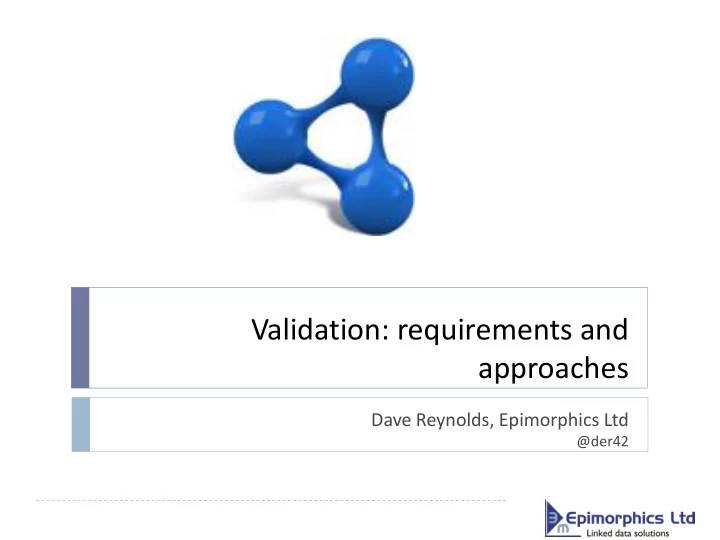

Validation: requirements and approaches Dave Reynolds, Epimorphics Ltd @der42
Validation requirements based on experiences with data.gov.uk Linked Data Most current Linked Data in data.gov.uk is: described using a range of vocabularies and documentation validated , if at all, by publisher using internal/ad hoc tooling Emerging requirement for shared validation approach: to enable interoperability so publishers know the shape of data required publishing tools can e.g. auto-populate forms consuming tools know what to expect Key requirements: declarative – easily inspectable by tools declared – can locate the structure definition for a data set accessible to mortals
A spread of requirements regular data statistics, financial, environmental measurements, ... irregular data organizational structure, strategic plans, ... controlled terms code lists, regulated entities, geographic regions, ...
Regular data use Data Cube vocabulary http://www.w3.org/TR/vocab-data-cube/ meets the requirements: declarative specification of structure - Data Structure Definition (DSD) declared: all observations link to DataSet link to DSD fairly understandable: :complianceDsd a qb:DataStructureDefinition; rdfs:label "complianceDsd"@en; qb:component [qb:dimension :bathingWater], [qb:dimension :samplingPoint], [qb:dimension :sampleYear], [qb:measure :complianceClassification], [qb:attribute :inYearDetail]; qb:sliceKey :complianceByYearKey, :complianceBySamplingPointKey .
But how to validate a data cube? Specification now defines “well - formed” cubes closed world notion of compliance with DSD integrity constraints specified by a set of SPARQL queries Lessons: SPARQL was sufficient to express all the required ICs some of the queries are convoluted and non-obvious at least one is quadratically slow unless optimizer is magic Useful compromise SPARQL doesn’t meet requirements of inspectable and understandable but tools and humans can operate at the DSD level
Irregular data typically mix-and-match range of vocabularies declare usage via void:vocabulary target users find OWL impenetrable requirement for “vocabulary profiles” closed-world constraints on properties (cardinalities, ranges) expressivity of closed-world OWL would be sufficient but need a presentation layer to simplify authoring and consumption – OSLC resource shapes? discovery mechanism
Controlled terms the other 80% of the problem common resource shapes the easy part interoperability means re-using terms for things in the domain sets of controlled terms (URI sets, code lists etc) can be very large often managed by third parties independent of data publisher and vocabulary definer can be dynamic typically handled by some form of registry governed, closed-world, lists of approved terms at point in time implication need ability to validate against external services such as registries
Recommend
More recommend